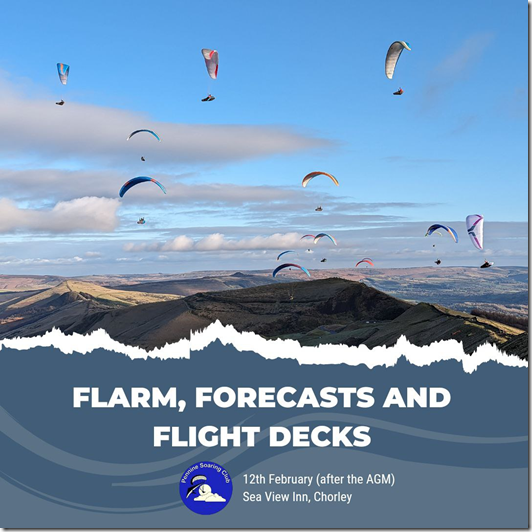In addition to the important business of the club AGM, our own Neil Charles will be giving us an update on the latest in Electronic Conspicuity and developments on his excellent Wind at Altitude site.
Winter Hill – New Gate Code active from Fri 2nd Feb 2024
By Andy Archer on February 4, 2024 14:46
Hi All,
The gate code for Winter Hill has been changed as of Friday 2nd Feb 24 @3pm.
Please contact a member of the committee for the new gate code (WhatsApp/text/Telegram/email/FB messenger)
Please follow the rules:
- Generally only the lower gate will be locked.
- If both gates are locked they will have the same code.
- The lock codes will be changed every 3 months or sooner if required.
- Do not allow anyone to tailgate you through the gate.
- Make sure the gate is locked shut behind you. Do not leave unlocked, even if you know another member will be on their way in a few minutes.
- On securing the lock ensure you scramble the code, DO NOT leave it on the unlock code.
- PSC members must obtain the code from a member of the committee, DO NOT distribute it further.
- Report any suspicious behaviour to a member of the committee.
Thanks
Andy
PSC Sites Officer
Safety Notes January 2024
By Brian Stewart on January 9, 2024 16:16
Happy new year everyone, and let’s look forward to a record-breaking year of banging thermals and wide open skies. Here’s a page from BHPA to get you ready for the coming season:

And here is some wise advice shamelessly cut and pasted from Guy Richardson in the DSC page:
1: Currency – this is the biggest cause of accidents, how long is it since you flew last? Are you desperate to fly? Is the weather going to give us a quick ‘Gap’? Being rusty is very common, Even the instructors go out and do a little practice. Make the time on a dry day (HAHAHA) to get your wing out and just do an hour ground handling – one hour is far more than you’d ever do sitting on a hill. Team up with a CP Buddy from the group and have a little fun. If you’re not sure where to go then give your coach a shout….. they’re not flying either!
2: Weather: Cold systems and slightly off directions tempt us to fly on a beautiful clear day, couple this with I’m rusty and it wont be pleasant. Watch the wind speeds at height, look out for the wave effect too. As it gets warmer we also have the land starting to release energy, when it starts its violent ‘Spring Thermals’ sometimes they feel like a small bomb has gone off! Be very aware, traditionally it’s the time of year in the club where we have the most incidents.
3: Kit: bring it out of the bag and fly after 3 months not flying and it’s a recipe for disaster. Do a full wing inspection – your lines shrink slightly in storage so it affects the handling of your wing, all the more reason to stretch those lines ground handling! Check your Harness, defluff your Velcro, extract your reserve to check it and while you’re at it, repack it! You’d be amazed how many reserves repackers find incorrectly installed! Check your carabiners (5 years life span). Charge and discharge your radio, make sure you have your Time out set (TOT) – normally 30 seconds to 1 minute. Check your Helmet for cracks.
Good - all ready….Me too! Don’t forget the repack event on 11th February and register if needed, there’s only a few places left.
IMSAFE
I – Ilness
M- Medication
S – Stress
A – Alcohol (& Drugs)
F – Fatigue
E – Emotion / Eyesight & Observation
Will Geordie Have His Cat Aboard Today?
W – Wind and Weather
G – Glider
H – Helmet
H – Harness
C – Controls
A – All Clear
T – Turn Direction
And finally, to reprise something I wrote about a couple of years ago, take care when people are ground handling/ launching wings. Last Sunday on Winter Hill, conditions were very light, almost not soarable. People were inflating and practising near the edge, and I stood behind someone, not really thinking about the danger. The wing suddenly came down on me, and wrapped some lines around my face. The calm had suddenly become gusty and the wing thrashed around but luckily I had my hand between my face and the lines, so nothing more than a surface scratch. But, the lessons here:
- Don’t stand behind people launching or ground handling – if it goes wrong, it’s only going to go one way, into you
- When you’re ground handling or launching, be aware of spectators who may stand in the wrong place and put themselves in danger – gently point out the problem to them
I know better, and still got caught out.
Tight lines
Social Night December 2023 - Andy Archer - Learning to fly microlights & the adventures beyond
By Carl Fairhurst on January 2, 2024 13:14
On Monday 11th December 2023, Andy Archer gave a talk on learning to fly 3 axis microlights.
A big thanks to Andy for giving this talk, For the benefit of anyone who couldn’t attend, we’ve recorded the meeting, click on the YouTube video below to watch.
